Health and Safety Risk Management in the Oil and Gas Industry
VerifiedAdded on 2021/10/27
|19
|4821
|135
Report
AI Summary
This report provides a comprehensive overview of health and safety practices within the oil and gas industry. It begins with an executive summary highlighting the importance of risk management in this hazardous sector, emphasizing the need for effective health and safety management plans. The report delves into risk management processes, including hazard identification, risk assessment tools, and techniques like the bowtie method. It examines relevant regulations and legislative compliance, such as HASAWA 1974, RIDDOR, COMAH, and DSAEAR, which are crucial for safeguarding the workforce. Several historical incidents are analyzed to identify negligence and their impact. The report concludes by emphasizing the importance of proactive risk management, comprehensive safety measures, and the need for continuous improvement in health and safety protocols to reduce occupational hazards and improve safety in the oil and gas industry.
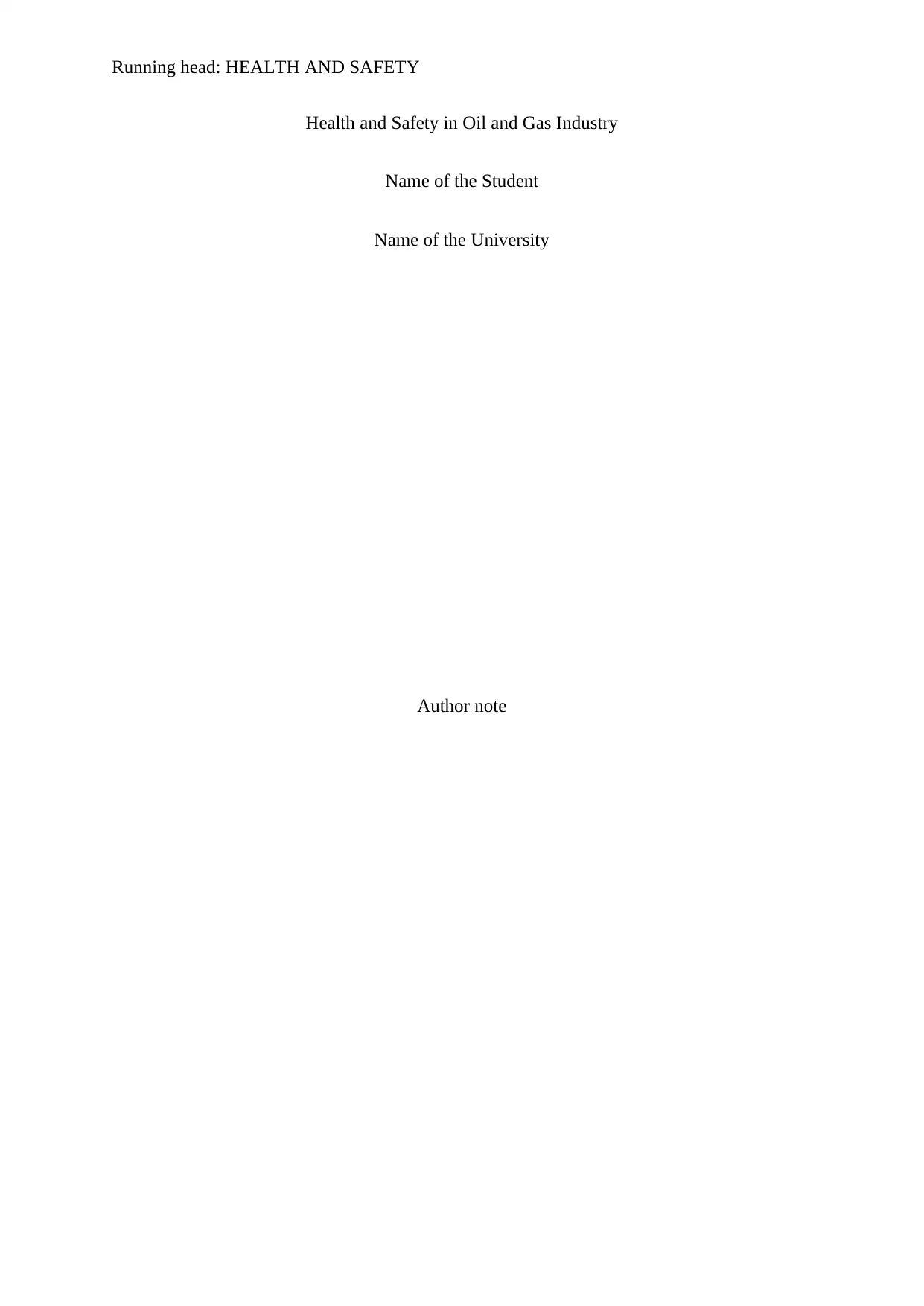
Running head: HEALTH AND SAFETY
Health and Safety in Oil and Gas Industry
Name of the Student
Name of the University
Author note
Health and Safety in Oil and Gas Industry
Name of the Student
Name of the University
Author note
Paraphrase This Document
Need a fresh take? Get an instant paraphrase of this document with our AI Paraphraser
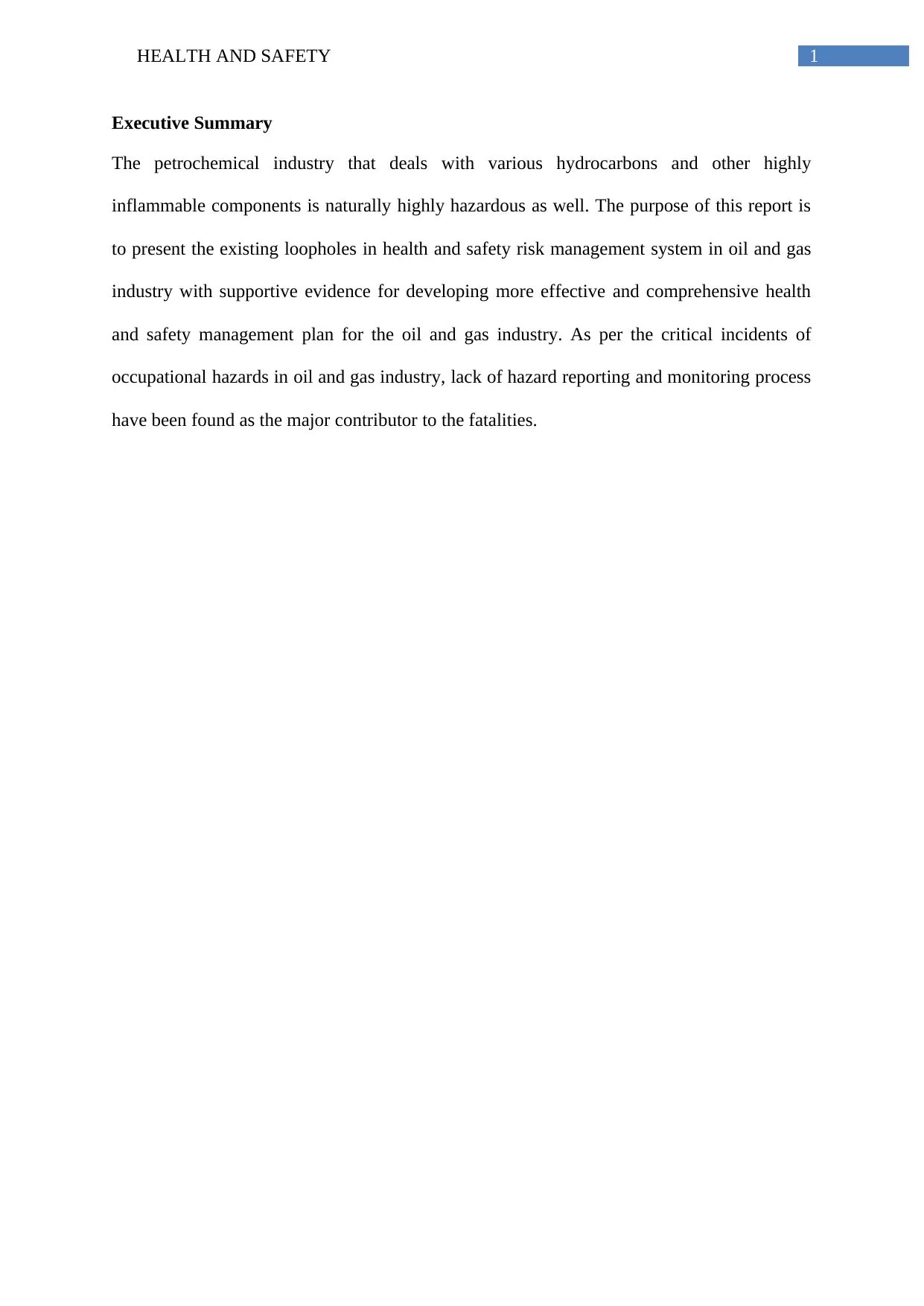
1HEALTH AND SAFETY
Executive Summary
The petrochemical industry that deals with various hydrocarbons and other highly
inflammable components is naturally highly hazardous as well. The purpose of this report is
to present the existing loopholes in health and safety risk management system in oil and gas
industry with supportive evidence for developing more effective and comprehensive health
and safety management plan for the oil and gas industry. As per the critical incidents of
occupational hazards in oil and gas industry, lack of hazard reporting and monitoring process
have been found as the major contributor to the fatalities.
Executive Summary
The petrochemical industry that deals with various hydrocarbons and other highly
inflammable components is naturally highly hazardous as well. The purpose of this report is
to present the existing loopholes in health and safety risk management system in oil and gas
industry with supportive evidence for developing more effective and comprehensive health
and safety management plan for the oil and gas industry. As per the critical incidents of
occupational hazards in oil and gas industry, lack of hazard reporting and monitoring process
have been found as the major contributor to the fatalities.

2HEALTH AND SAFETY
Table of Content
Introduction:...............................................................................................................................3
Risks Management within the oil and gas industry:..................................................................4
Risk assessment tools and techniques:.......................................................................................4
Regulations and legislative compliance of risk management:...................................................7
Historical incidents in oil and gas industry:.............................................................................10
List of cases:.........................................................................................................................10
Analysis of Incidents............................................................................................................13
Offshore case study and justifications:....................................................................................14
Conclusion:..............................................................................................................................16
Reference:................................................................................................................................17
Table of Content
Introduction:...............................................................................................................................3
Risks Management within the oil and gas industry:..................................................................4
Risk assessment tools and techniques:.......................................................................................4
Regulations and legislative compliance of risk management:...................................................7
Historical incidents in oil and gas industry:.............................................................................10
List of cases:.........................................................................................................................10
Analysis of Incidents............................................................................................................13
Offshore case study and justifications:....................................................................................14
Conclusion:..............................................................................................................................16
Reference:................................................................................................................................17
⊘ This is a preview!⊘
Do you want full access?
Subscribe today to unlock all pages.

Trusted by 1+ million students worldwide
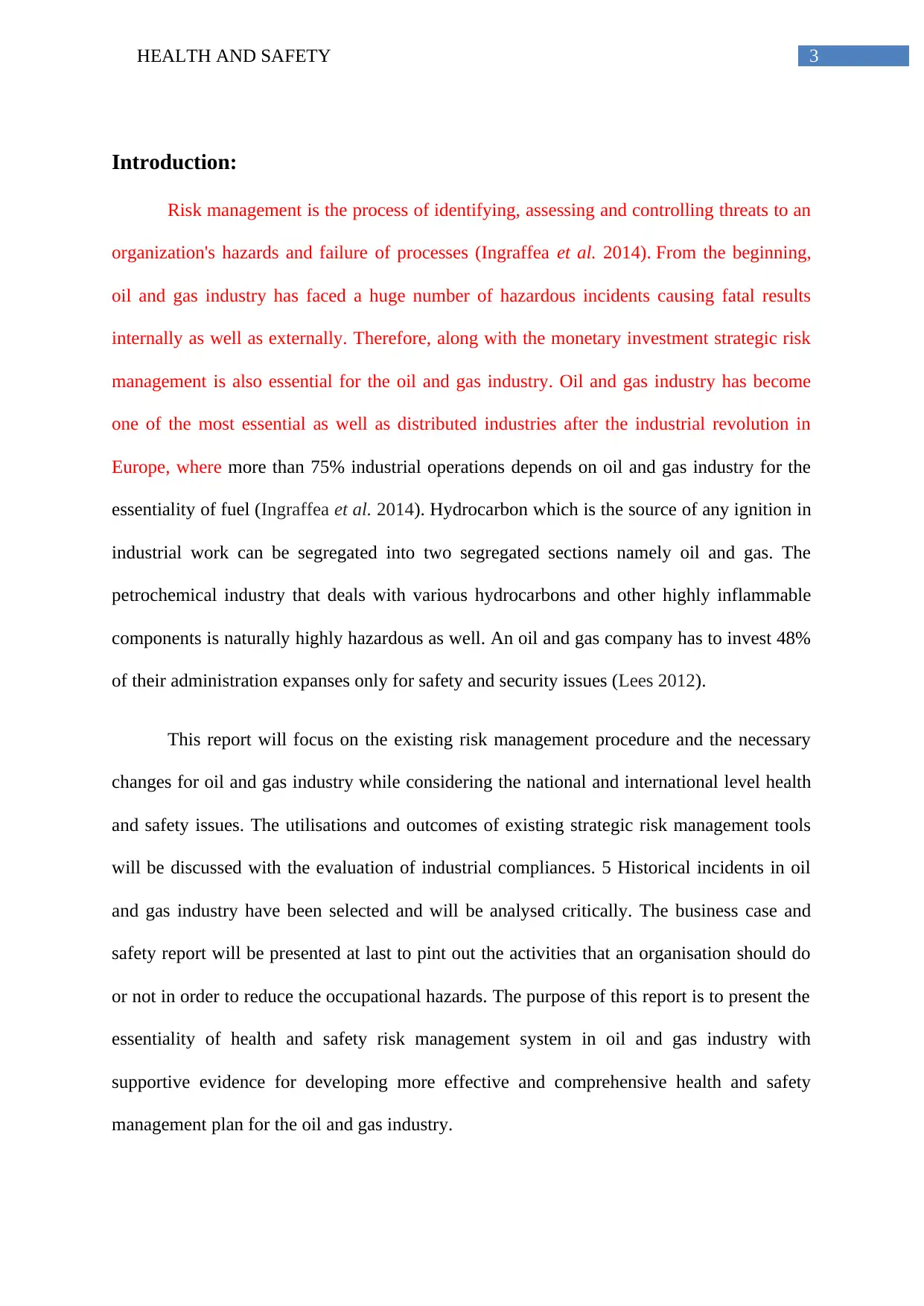
3HEALTH AND SAFETY
Introduction:
Risk management is the process of identifying, assessing and controlling threats to an
organization's hazards and failure of processes (Ingraffea et al. 2014). From the beginning,
oil and gas industry has faced a huge number of hazardous incidents causing fatal results
internally as well as externally. Therefore, along with the monetary investment strategic risk
management is also essential for the oil and gas industry. Oil and gas industry has become
one of the most essential as well as distributed industries after the industrial revolution in
Europe, where more than 75% industrial operations depends on oil and gas industry for the
essentiality of fuel (Ingraffea et al. 2014). Hydrocarbon which is the source of any ignition in
industrial work can be segregated into two segregated sections namely oil and gas. The
petrochemical industry that deals with various hydrocarbons and other highly inflammable
components is naturally highly hazardous as well. An oil and gas company has to invest 48%
of their administration expanses only for safety and security issues (Lees 2012).
This report will focus on the existing risk management procedure and the necessary
changes for oil and gas industry while considering the national and international level health
and safety issues. The utilisations and outcomes of existing strategic risk management tools
will be discussed with the evaluation of industrial compliances. 5 Historical incidents in oil
and gas industry have been selected and will be analysed critically. The business case and
safety report will be presented at last to pint out the activities that an organisation should do
or not in order to reduce the occupational hazards. The purpose of this report is to present the
essentiality of health and safety risk management system in oil and gas industry with
supportive evidence for developing more effective and comprehensive health and safety
management plan for the oil and gas industry.
Introduction:
Risk management is the process of identifying, assessing and controlling threats to an
organization's hazards and failure of processes (Ingraffea et al. 2014). From the beginning,
oil and gas industry has faced a huge number of hazardous incidents causing fatal results
internally as well as externally. Therefore, along with the monetary investment strategic risk
management is also essential for the oil and gas industry. Oil and gas industry has become
one of the most essential as well as distributed industries after the industrial revolution in
Europe, where more than 75% industrial operations depends on oil and gas industry for the
essentiality of fuel (Ingraffea et al. 2014). Hydrocarbon which is the source of any ignition in
industrial work can be segregated into two segregated sections namely oil and gas. The
petrochemical industry that deals with various hydrocarbons and other highly inflammable
components is naturally highly hazardous as well. An oil and gas company has to invest 48%
of their administration expanses only for safety and security issues (Lees 2012).
This report will focus on the existing risk management procedure and the necessary
changes for oil and gas industry while considering the national and international level health
and safety issues. The utilisations and outcomes of existing strategic risk management tools
will be discussed with the evaluation of industrial compliances. 5 Historical incidents in oil
and gas industry have been selected and will be analysed critically. The business case and
safety report will be presented at last to pint out the activities that an organisation should do
or not in order to reduce the occupational hazards. The purpose of this report is to present the
essentiality of health and safety risk management system in oil and gas industry with
supportive evidence for developing more effective and comprehensive health and safety
management plan for the oil and gas industry.
Paraphrase This Document
Need a fresh take? Get an instant paraphrase of this document with our AI Paraphraser
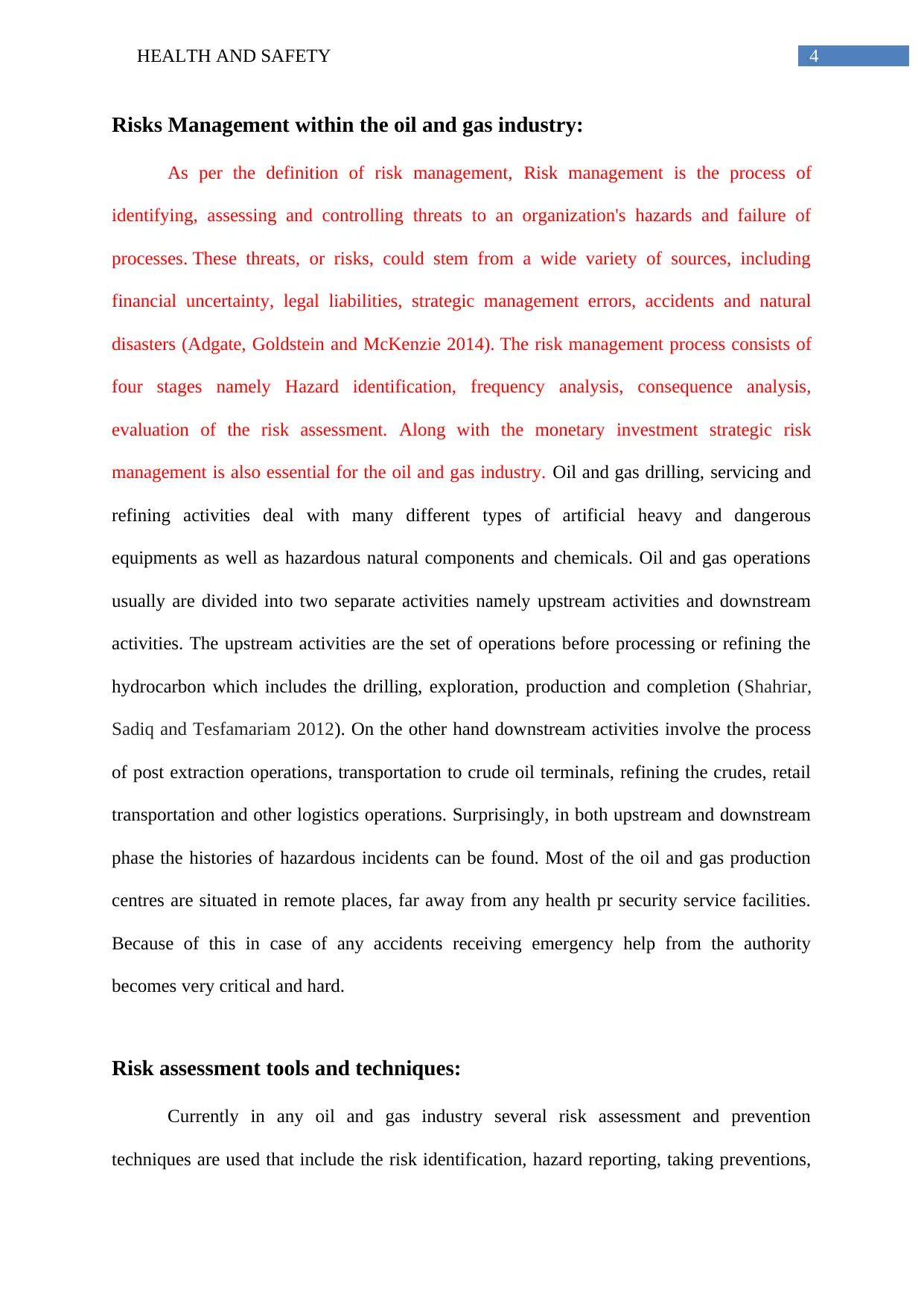
4HEALTH AND SAFETY
Risks Management within the oil and gas industry:
As per the definition of risk management, Risk management is the process of
identifying, assessing and controlling threats to an organization's hazards and failure of
processes. These threats, or risks, could stem from a wide variety of sources, including
financial uncertainty, legal liabilities, strategic management errors, accidents and natural
disasters (Adgate, Goldstein and McKenzie 2014). The risk management process consists of
four stages namely Hazard identification, frequency analysis, consequence analysis,
evaluation of the risk assessment. Along with the monetary investment strategic risk
management is also essential for the oil and gas industry. Oil and gas drilling, servicing and
refining activities deal with many different types of artificial heavy and dangerous
equipments as well as hazardous natural components and chemicals. Oil and gas operations
usually are divided into two separate activities namely upstream activities and downstream
activities. The upstream activities are the set of operations before processing or refining the
hydrocarbon which includes the drilling, exploration, production and completion (Shahriar,
Sadiq and Tesfamariam 2012). On the other hand downstream activities involve the process
of post extraction operations, transportation to crude oil terminals, refining the crudes, retail
transportation and other logistics operations. Surprisingly, in both upstream and downstream
phase the histories of hazardous incidents can be found. Most of the oil and gas production
centres are situated in remote places, far away from any health pr security service facilities.
Because of this in case of any accidents receiving emergency help from the authority
becomes very critical and hard.
Risk assessment tools and techniques:
Currently in any oil and gas industry several risk assessment and prevention
techniques are used that include the risk identification, hazard reporting, taking preventions,
Risks Management within the oil and gas industry:
As per the definition of risk management, Risk management is the process of
identifying, assessing and controlling threats to an organization's hazards and failure of
processes. These threats, or risks, could stem from a wide variety of sources, including
financial uncertainty, legal liabilities, strategic management errors, accidents and natural
disasters (Adgate, Goldstein and McKenzie 2014). The risk management process consists of
four stages namely Hazard identification, frequency analysis, consequence analysis,
evaluation of the risk assessment. Along with the monetary investment strategic risk
management is also essential for the oil and gas industry. Oil and gas drilling, servicing and
refining activities deal with many different types of artificial heavy and dangerous
equipments as well as hazardous natural components and chemicals. Oil and gas operations
usually are divided into two separate activities namely upstream activities and downstream
activities. The upstream activities are the set of operations before processing or refining the
hydrocarbon which includes the drilling, exploration, production and completion (Shahriar,
Sadiq and Tesfamariam 2012). On the other hand downstream activities involve the process
of post extraction operations, transportation to crude oil terminals, refining the crudes, retail
transportation and other logistics operations. Surprisingly, in both upstream and downstream
phase the histories of hazardous incidents can be found. Most of the oil and gas production
centres are situated in remote places, far away from any health pr security service facilities.
Because of this in case of any accidents receiving emergency help from the authority
becomes very critical and hard.
Risk assessment tools and techniques:
Currently in any oil and gas industry several risk assessment and prevention
techniques are used that include the risk identification, hazard reporting, taking preventions,
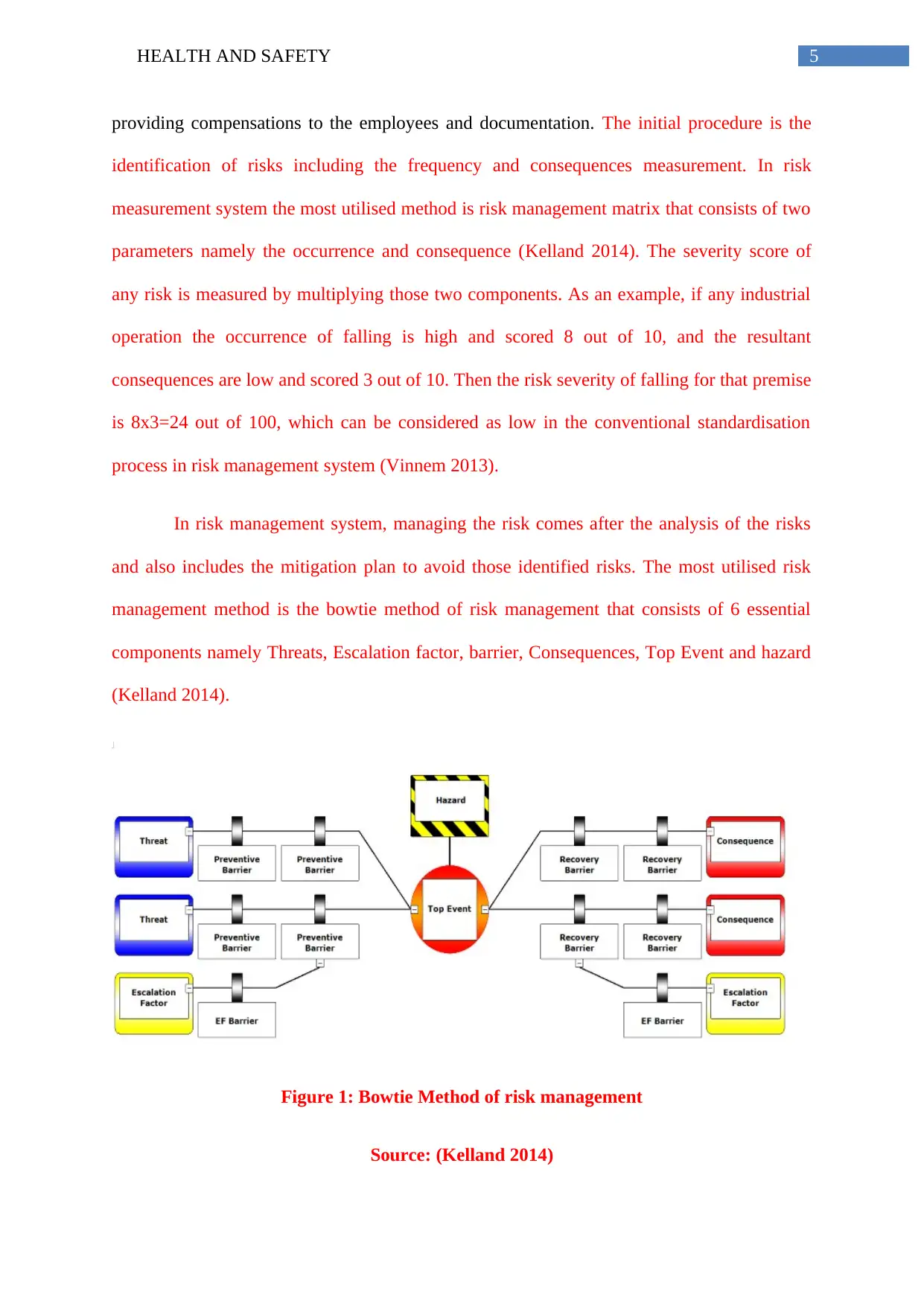
5HEALTH AND SAFETY
providing compensations to the employees and documentation. The initial procedure is the
identification of risks including the frequency and consequences measurement. In risk
measurement system the most utilised method is risk management matrix that consists of two
parameters namely the occurrence and consequence (Kelland 2014). The severity score of
any risk is measured by multiplying those two components. As an example, if any industrial
operation the occurrence of falling is high and scored 8 out of 10, and the resultant
consequences are low and scored 3 out of 10. Then the risk severity of falling for that premise
is 8x3=24 out of 100, which can be considered as low in the conventional standardisation
process in risk management system (Vinnem 2013).
In risk management system, managing the risk comes after the analysis of the risks
and also includes the mitigation plan to avoid those identified risks. The most utilised risk
management method is the bowtie method of risk management that consists of 6 essential
components namely Threats, Escalation factor, barrier, Consequences, Top Event and hazard
(Kelland 2014).
Figure 1: Bowtie Method of risk management
Source: (Kelland 2014)
providing compensations to the employees and documentation. The initial procedure is the
identification of risks including the frequency and consequences measurement. In risk
measurement system the most utilised method is risk management matrix that consists of two
parameters namely the occurrence and consequence (Kelland 2014). The severity score of
any risk is measured by multiplying those two components. As an example, if any industrial
operation the occurrence of falling is high and scored 8 out of 10, and the resultant
consequences are low and scored 3 out of 10. Then the risk severity of falling for that premise
is 8x3=24 out of 100, which can be considered as low in the conventional standardisation
process in risk management system (Vinnem 2013).
In risk management system, managing the risk comes after the analysis of the risks
and also includes the mitigation plan to avoid those identified risks. The most utilised risk
management method is the bowtie method of risk management that consists of 6 essential
components namely Threats, Escalation factor, barrier, Consequences, Top Event and hazard
(Kelland 2014).
Figure 1: Bowtie Method of risk management
Source: (Kelland 2014)
⊘ This is a preview!⊘
Do you want full access?
Subscribe today to unlock all pages.

Trusted by 1+ million students worldwide
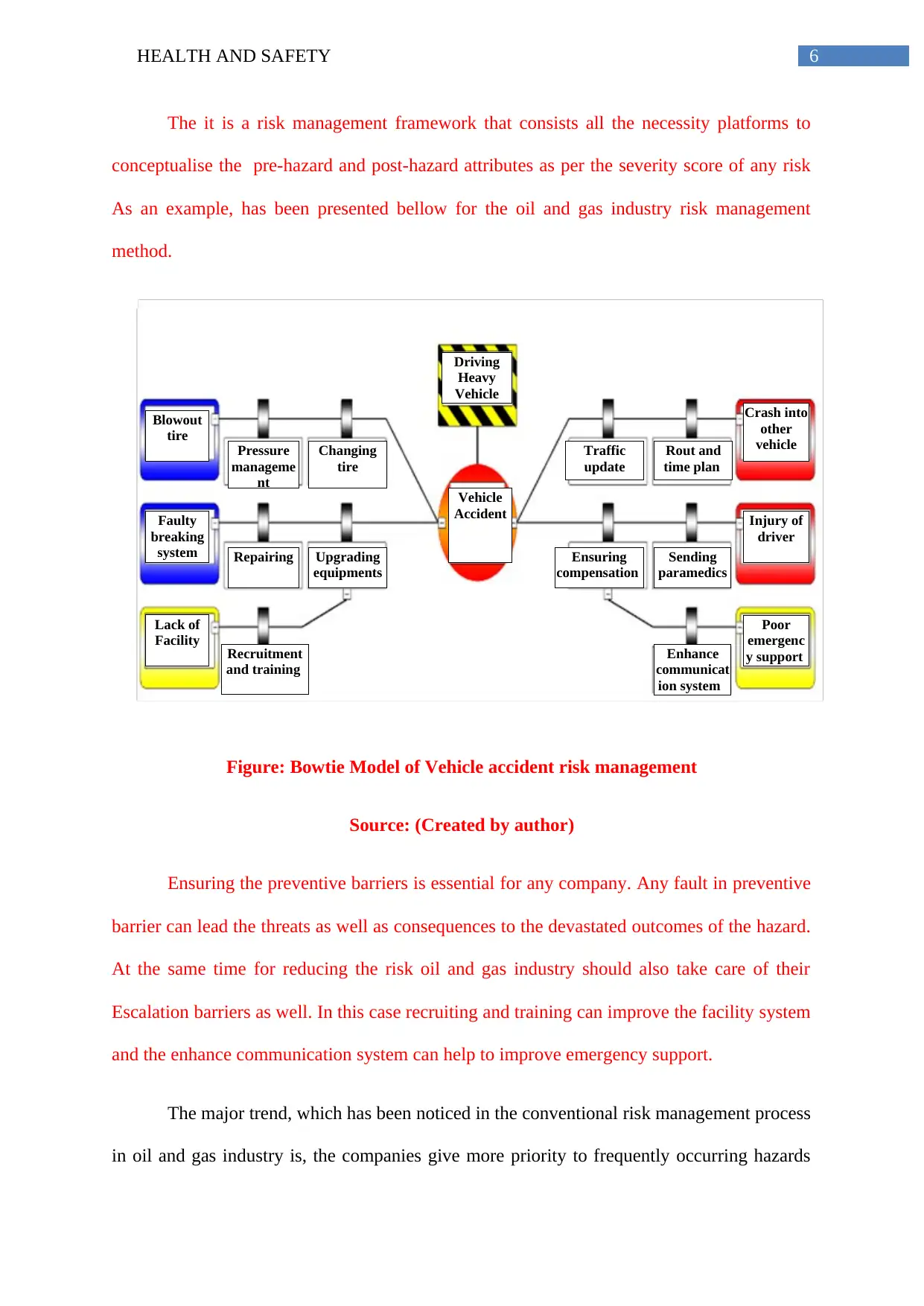
6HEALTH AND SAFETY
Driving
Heavy
Vehicle
Vehicle
Accident
Blowout
tire
Faulty
breaking
system
Lack of
Facility Recruitment
and training
Upgrading
equipments
Repairing
Changing
tire
Pressure
manageme
nt
Crash into
other
vehicle
Injury of
driver
Poor
emergenc
y supportEnhance
communicat
ion system
Sending
paramedics
Ensuring
compensation
Rout and
time plan
Traffic
update
The it is a risk management framework that consists all the necessity platforms to
conceptualise the pre-hazard and post-hazard attributes as per the severity score of any risk
As an example, has been presented bellow for the oil and gas industry risk management
method.
Figure: Bowtie Model of Vehicle accident risk management
Source: (Created by author)
Ensuring the preventive barriers is essential for any company. Any fault in preventive
barrier can lead the threats as well as consequences to the devastated outcomes of the hazard.
At the same time for reducing the risk oil and gas industry should also take care of their
Escalation barriers as well. In this case recruiting and training can improve the facility system
and the enhance communication system can help to improve emergency support.
The major trend, which has been noticed in the conventional risk management process
in oil and gas industry is, the companies give more priority to frequently occurring hazards
Driving
Heavy
Vehicle
Vehicle
Accident
Blowout
tire
Faulty
breaking
system
Lack of
Facility Recruitment
and training
Upgrading
equipments
Repairing
Changing
tire
Pressure
manageme
nt
Crash into
other
vehicle
Injury of
driver
Poor
emergenc
y supportEnhance
communicat
ion system
Sending
paramedics
Ensuring
compensation
Rout and
time plan
Traffic
update
The it is a risk management framework that consists all the necessity platforms to
conceptualise the pre-hazard and post-hazard attributes as per the severity score of any risk
As an example, has been presented bellow for the oil and gas industry risk management
method.
Figure: Bowtie Model of Vehicle accident risk management
Source: (Created by author)
Ensuring the preventive barriers is essential for any company. Any fault in preventive
barrier can lead the threats as well as consequences to the devastated outcomes of the hazard.
At the same time for reducing the risk oil and gas industry should also take care of their
Escalation barriers as well. In this case recruiting and training can improve the facility system
and the enhance communication system can help to improve emergency support.
The major trend, which has been noticed in the conventional risk management process
in oil and gas industry is, the companies give more priority to frequently occurring hazards
Paraphrase This Document
Need a fresh take? Get an instant paraphrase of this document with our AI Paraphraser
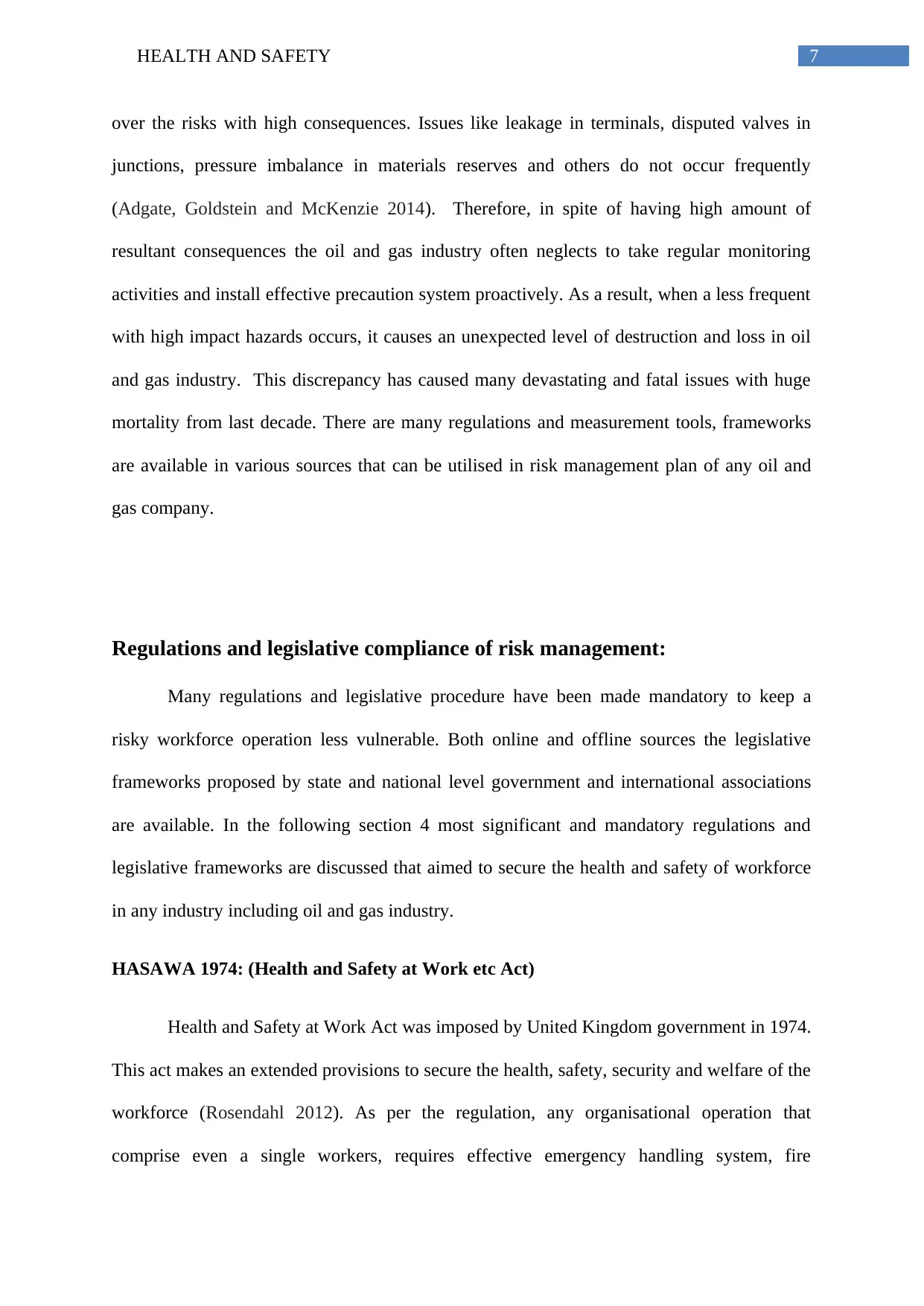
7HEALTH AND SAFETY
over the risks with high consequences. Issues like leakage in terminals, disputed valves in
junctions, pressure imbalance in materials reserves and others do not occur frequently
(Adgate, Goldstein and McKenzie 2014). Therefore, in spite of having high amount of
resultant consequences the oil and gas industry often neglects to take regular monitoring
activities and install effective precaution system proactively. As a result, when a less frequent
with high impact hazards occurs, it causes an unexpected level of destruction and loss in oil
and gas industry. This discrepancy has caused many devastating and fatal issues with huge
mortality from last decade. There are many regulations and measurement tools, frameworks
are available in various sources that can be utilised in risk management plan of any oil and
gas company.
Regulations and legislative compliance of risk management:
Many regulations and legislative procedure have been made mandatory to keep a
risky workforce operation less vulnerable. Both online and offline sources the legislative
frameworks proposed by state and national level government and international associations
are available. In the following section 4 most significant and mandatory regulations and
legislative frameworks are discussed that aimed to secure the health and safety of workforce
in any industry including oil and gas industry.
HASAWA 1974: (Health and Safety at Work etc Act)
Health and Safety at Work Act was imposed by United Kingdom government in 1974.
This act makes an extended provisions to secure the health, safety, security and welfare of the
workforce (Rosendahl 2012). As per the regulation, any organisational operation that
comprise even a single workers, requires effective emergency handling system, fire
over the risks with high consequences. Issues like leakage in terminals, disputed valves in
junctions, pressure imbalance in materials reserves and others do not occur frequently
(Adgate, Goldstein and McKenzie 2014). Therefore, in spite of having high amount of
resultant consequences the oil and gas industry often neglects to take regular monitoring
activities and install effective precaution system proactively. As a result, when a less frequent
with high impact hazards occurs, it causes an unexpected level of destruction and loss in oil
and gas industry. This discrepancy has caused many devastating and fatal issues with huge
mortality from last decade. There are many regulations and measurement tools, frameworks
are available in various sources that can be utilised in risk management plan of any oil and
gas company.
Regulations and legislative compliance of risk management:
Many regulations and legislative procedure have been made mandatory to keep a
risky workforce operation less vulnerable. Both online and offline sources the legislative
frameworks proposed by state and national level government and international associations
are available. In the following section 4 most significant and mandatory regulations and
legislative frameworks are discussed that aimed to secure the health and safety of workforce
in any industry including oil and gas industry.
HASAWA 1974: (Health and Safety at Work etc Act)
Health and Safety at Work Act was imposed by United Kingdom government in 1974.
This act makes an extended provisions to secure the health, safety, security and welfare of the
workforce (Rosendahl 2012). As per the regulation, any organisational operation that
comprise even a single workers, requires effective emergency handling system, fire
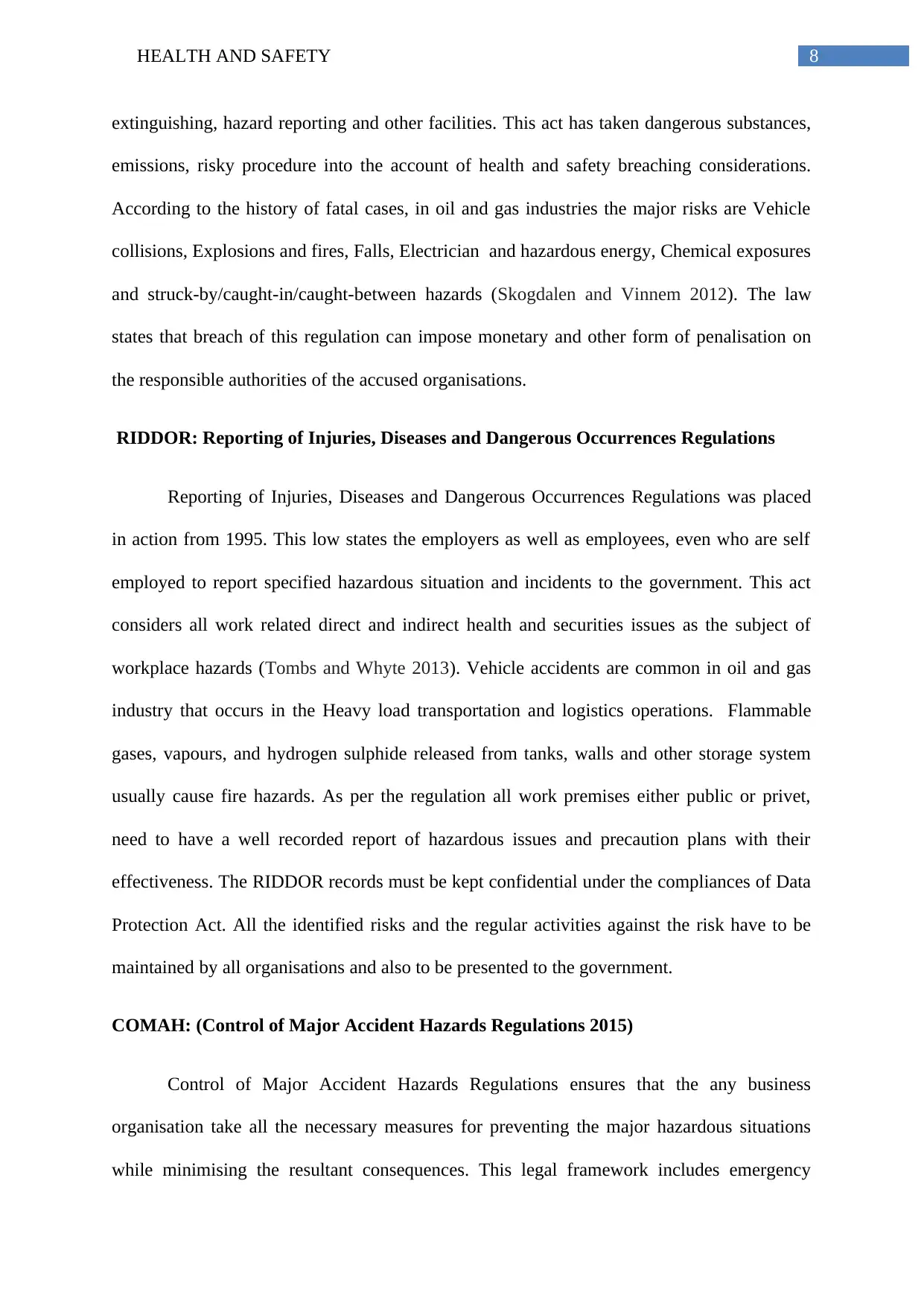
8HEALTH AND SAFETY
extinguishing, hazard reporting and other facilities. This act has taken dangerous substances,
emissions, risky procedure into the account of health and safety breaching considerations.
According to the history of fatal cases, in oil and gas industries the major risks are Vehicle
collisions, Explosions and fires, Falls, Electrician and hazardous energy, Chemical exposures
and struck-by/caught-in/caught-between hazards (Skogdalen and Vinnem 2012). The law
states that breach of this regulation can impose monetary and other form of penalisation on
the responsible authorities of the accused organisations.
RIDDOR: Reporting of Injuries, Diseases and Dangerous Occurrences Regulations
Reporting of Injuries, Diseases and Dangerous Occurrences Regulations was placed
in action from 1995. This low states the employers as well as employees, even who are self
employed to report specified hazardous situation and incidents to the government. This act
considers all work related direct and indirect health and securities issues as the subject of
workplace hazards (Tombs and Whyte 2013). Vehicle accidents are common in oil and gas
industry that occurs in the Heavy load transportation and logistics operations. Flammable
gases, vapours, and hydrogen sulphide released from tanks, walls and other storage system
usually cause fire hazards. As per the regulation all work premises either public or privet,
need to have a well recorded report of hazardous issues and precaution plans with their
effectiveness. The RIDDOR records must be kept confidential under the compliances of Data
Protection Act. All the identified risks and the regular activities against the risk have to be
maintained by all organisations and also to be presented to the government.
COMAH: (Control of Major Accident Hazards Regulations 2015)
Control of Major Accident Hazards Regulations ensures that the any business
organisation take all the necessary measures for preventing the major hazardous situations
while minimising the resultant consequences. This legal framework includes emergency
extinguishing, hazard reporting and other facilities. This act has taken dangerous substances,
emissions, risky procedure into the account of health and safety breaching considerations.
According to the history of fatal cases, in oil and gas industries the major risks are Vehicle
collisions, Explosions and fires, Falls, Electrician and hazardous energy, Chemical exposures
and struck-by/caught-in/caught-between hazards (Skogdalen and Vinnem 2012). The law
states that breach of this regulation can impose monetary and other form of penalisation on
the responsible authorities of the accused organisations.
RIDDOR: Reporting of Injuries, Diseases and Dangerous Occurrences Regulations
Reporting of Injuries, Diseases and Dangerous Occurrences Regulations was placed
in action from 1995. This low states the employers as well as employees, even who are self
employed to report specified hazardous situation and incidents to the government. This act
considers all work related direct and indirect health and securities issues as the subject of
workplace hazards (Tombs and Whyte 2013). Vehicle accidents are common in oil and gas
industry that occurs in the Heavy load transportation and logistics operations. Flammable
gases, vapours, and hydrogen sulphide released from tanks, walls and other storage system
usually cause fire hazards. As per the regulation all work premises either public or privet,
need to have a well recorded report of hazardous issues and precaution plans with their
effectiveness. The RIDDOR records must be kept confidential under the compliances of Data
Protection Act. All the identified risks and the regular activities against the risk have to be
maintained by all organisations and also to be presented to the government.
COMAH: (Control of Major Accident Hazards Regulations 2015)
Control of Major Accident Hazards Regulations ensures that the any business
organisation take all the necessary measures for preventing the major hazardous situations
while minimising the resultant consequences. This legal framework includes emergency
⊘ This is a preview!⊘
Do you want full access?
Subscribe today to unlock all pages.

Trusted by 1+ million students worldwide
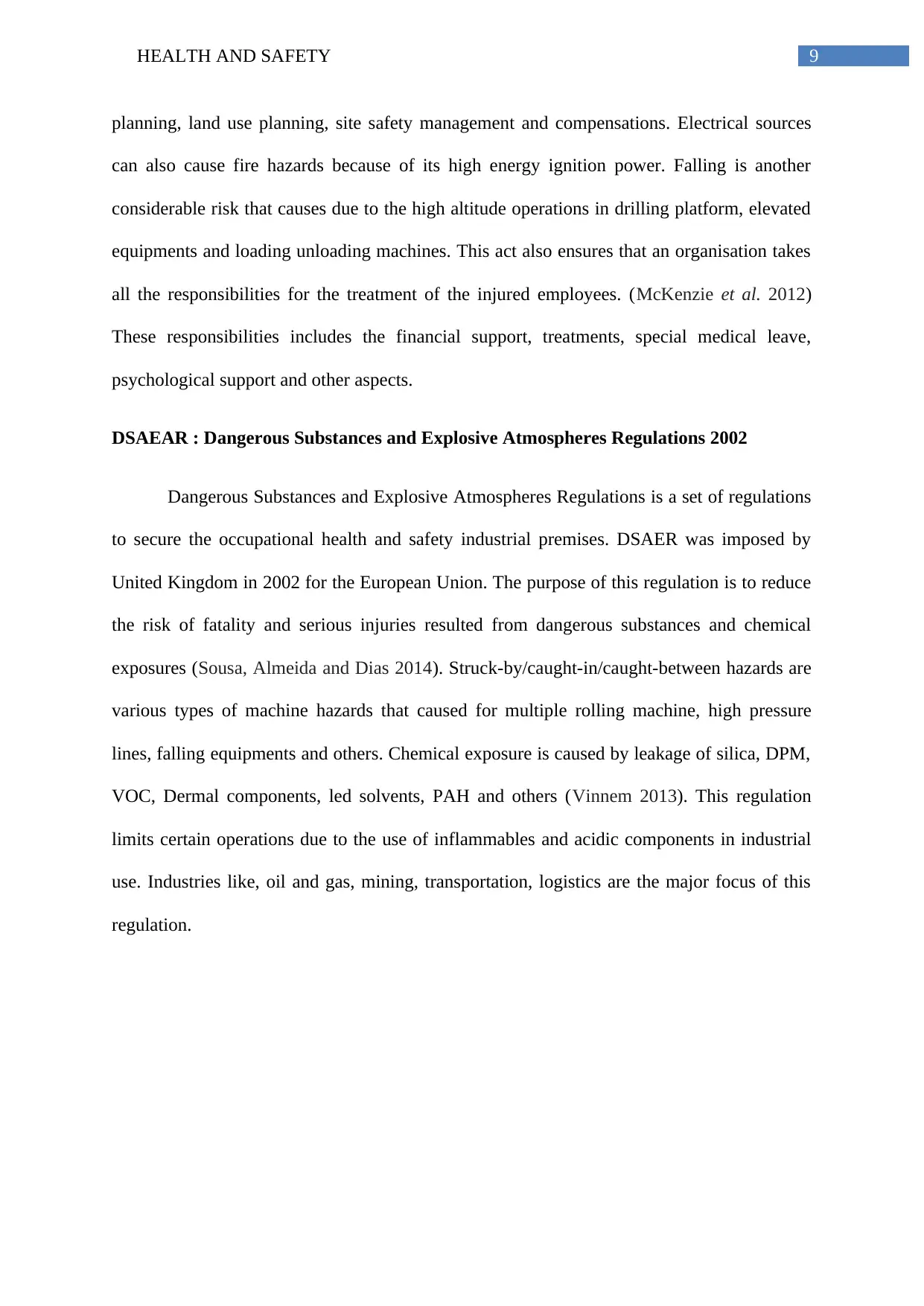
9HEALTH AND SAFETY
planning, land use planning, site safety management and compensations. Electrical sources
can also cause fire hazards because of its high energy ignition power. Falling is another
considerable risk that causes due to the high altitude operations in drilling platform, elevated
equipments and loading unloading machines. This act also ensures that an organisation takes
all the responsibilities for the treatment of the injured employees. (McKenzie et al. 2012)
These responsibilities includes the financial support, treatments, special medical leave,
psychological support and other aspects.
DSAEAR : Dangerous Substances and Explosive Atmospheres Regulations 2002
Dangerous Substances and Explosive Atmospheres Regulations is a set of regulations
to secure the occupational health and safety industrial premises. DSAER was imposed by
United Kingdom in 2002 for the European Union. The purpose of this regulation is to reduce
the risk of fatality and serious injuries resulted from dangerous substances and chemical
exposures (Sousa, Almeida and Dias 2014). Struck-by/caught-in/caught-between hazards are
various types of machine hazards that caused for multiple rolling machine, high pressure
lines, falling equipments and others. Chemical exposure is caused by leakage of silica, DPM,
VOC, Dermal components, led solvents, PAH and others (Vinnem 2013). This regulation
limits certain operations due to the use of inflammables and acidic components in industrial
use. Industries like, oil and gas, mining, transportation, logistics are the major focus of this
regulation.
planning, land use planning, site safety management and compensations. Electrical sources
can also cause fire hazards because of its high energy ignition power. Falling is another
considerable risk that causes due to the high altitude operations in drilling platform, elevated
equipments and loading unloading machines. This act also ensures that an organisation takes
all the responsibilities for the treatment of the injured employees. (McKenzie et al. 2012)
These responsibilities includes the financial support, treatments, special medical leave,
psychological support and other aspects.
DSAEAR : Dangerous Substances and Explosive Atmospheres Regulations 2002
Dangerous Substances and Explosive Atmospheres Regulations is a set of regulations
to secure the occupational health and safety industrial premises. DSAER was imposed by
United Kingdom in 2002 for the European Union. The purpose of this regulation is to reduce
the risk of fatality and serious injuries resulted from dangerous substances and chemical
exposures (Sousa, Almeida and Dias 2014). Struck-by/caught-in/caught-between hazards are
various types of machine hazards that caused for multiple rolling machine, high pressure
lines, falling equipments and others. Chemical exposure is caused by leakage of silica, DPM,
VOC, Dermal components, led solvents, PAH and others (Vinnem 2013). This regulation
limits certain operations due to the use of inflammables and acidic components in industrial
use. Industries like, oil and gas, mining, transportation, logistics are the major focus of this
regulation.
Paraphrase This Document
Need a fresh take? Get an instant paraphrase of this document with our AI Paraphraser

10HEALTH AND SAFETY
Historical incidents in oil and gas industry:
List of cases:
Date Location Fatalities Consequences Identification of
Hazard (negligence in
terms of hazardous
regulation)
27 March
1980
Norway
(Alexander
L. Kielland,
North Sea,
Norway)
The accident
killed 123
people
The accident led to the
provision of appointment
of s command
organization who would
give clear order to
abandonment during the
time of emergency. This
tragedy also led to the
requirement of lifeboats
hooks and also
establishment of structures
which will facilitate the
faster abandonment of the
sinking oil rigs.
The accident occurred
because of a crack in
the 6 bracings that
held the entire rig.
Also the investigation
found significant
amount of lamellar
tearing in the in the
flange plate (Hannevik
et al., 2014).
15
February
1982
Canada (The
Ocean
Ranger
Disaster)
All the 84
crew that
included the
38
contractors
The commission that was
formed for the inquiry of
the incident recommended
that federal government
must invest every year into
It was found that the
crew not properly
trained and the
number of the safety
equipment were
Historical incidents in oil and gas industry:
List of cases:
Date Location Fatalities Consequences Identification of
Hazard (negligence in
terms of hazardous
regulation)
27 March
1980
Norway
(Alexander
L. Kielland,
North Sea,
Norway)
The accident
killed 123
people
The accident led to the
provision of appointment
of s command
organization who would
give clear order to
abandonment during the
time of emergency. This
tragedy also led to the
requirement of lifeboats
hooks and also
establishment of structures
which will facilitate the
faster abandonment of the
sinking oil rigs.
The accident occurred
because of a crack in
the 6 bracings that
held the entire rig.
Also the investigation
found significant
amount of lamellar
tearing in the in the
flange plate (Hannevik
et al., 2014).
15
February
1982
Canada (The
Ocean
Ranger
Disaster)
All the 84
crew that
included the
38
contractors
The commission that was
formed for the inquiry of
the incident recommended
that federal government
must invest every year into
It was found that the
crew not properly
trained and the
number of the safety
equipment were
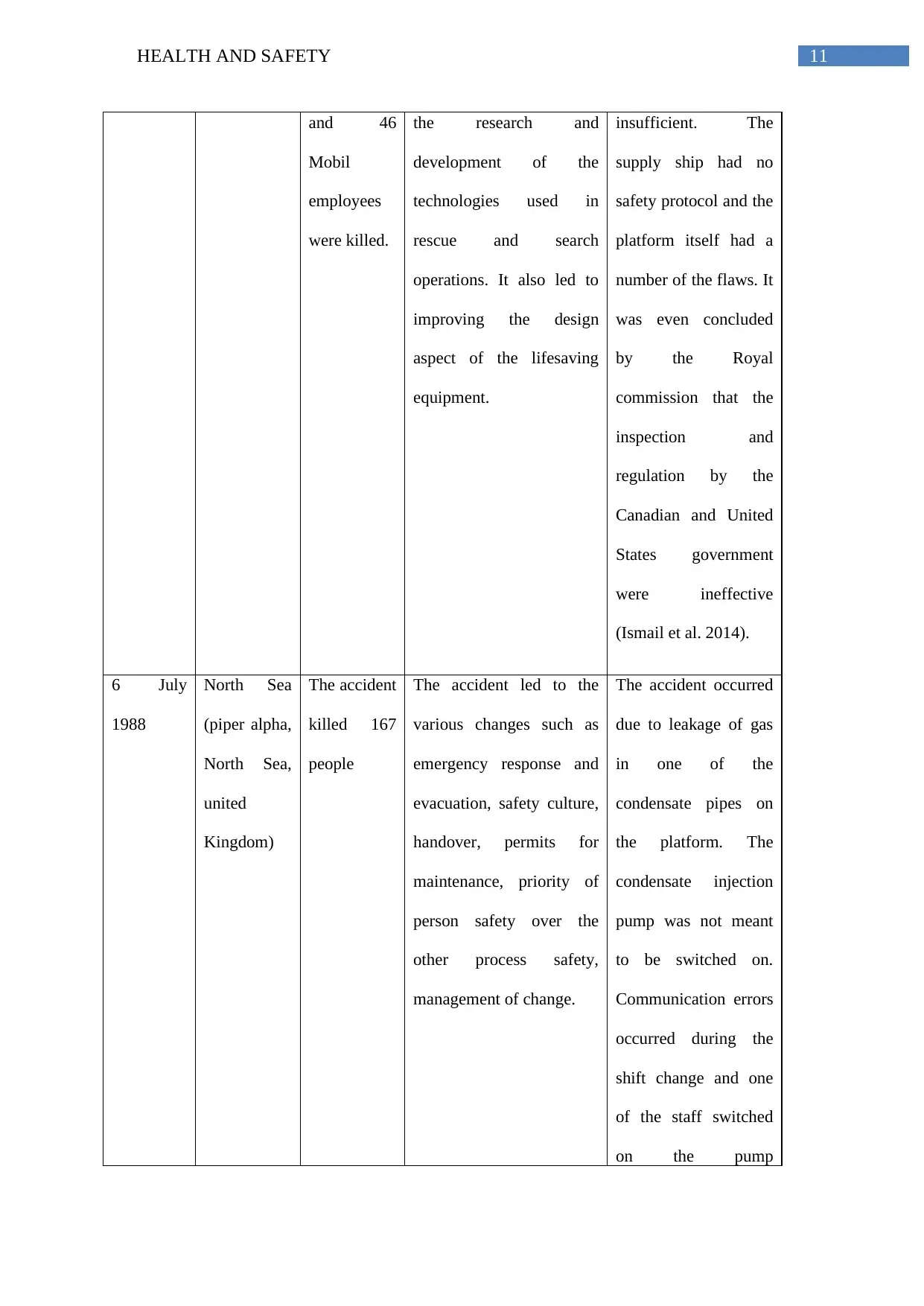
11HEALTH AND SAFETY
and 46
Mobil
employees
were killed.
the research and
development of the
technologies used in
rescue and search
operations. It also led to
improving the design
aspect of the lifesaving
equipment.
insufficient. The
supply ship had no
safety protocol and the
platform itself had a
number of the flaws. It
was even concluded
by the Royal
commission that the
inspection and
regulation by the
Canadian and United
States government
were ineffective
(Ismail et al. 2014).
6 July
1988
North Sea
(piper alpha,
North Sea,
united
Kingdom)
The accident
killed 167
people
The accident led to the
various changes such as
emergency response and
evacuation, safety culture,
handover, permits for
maintenance, priority of
person safety over the
other process safety,
management of change.
The accident occurred
due to leakage of gas
in one of the
condensate pipes on
the platform. The
condensate injection
pump was not meant
to be switched on.
Communication errors
occurred during the
shift change and one
of the staff switched
on the pump
and 46
Mobil
employees
were killed.
the research and
development of the
technologies used in
rescue and search
operations. It also led to
improving the design
aspect of the lifesaving
equipment.
insufficient. The
supply ship had no
safety protocol and the
platform itself had a
number of the flaws. It
was even concluded
by the Royal
commission that the
inspection and
regulation by the
Canadian and United
States government
were ineffective
(Ismail et al. 2014).
6 July
1988
North Sea
(piper alpha,
North Sea,
united
Kingdom)
The accident
killed 167
people
The accident led to the
various changes such as
emergency response and
evacuation, safety culture,
handover, permits for
maintenance, priority of
person safety over the
other process safety,
management of change.
The accident occurred
due to leakage of gas
in one of the
condensate pipes on
the platform. The
condensate injection
pump was not meant
to be switched on.
Communication errors
occurred during the
shift change and one
of the staff switched
on the pump
⊘ This is a preview!⊘
Do you want full access?
Subscribe today to unlock all pages.

Trusted by 1+ million students worldwide
1 out of 19
Related Documents
Your All-in-One AI-Powered Toolkit for Academic Success.
+13062052269
info@desklib.com
Available 24*7 on WhatsApp / Email
![[object Object]](/_next/static/media/star-bottom.7253800d.svg)
Unlock your academic potential
Copyright © 2020–2025 A2Z Services. All Rights Reserved. Developed and managed by ZUCOL.





